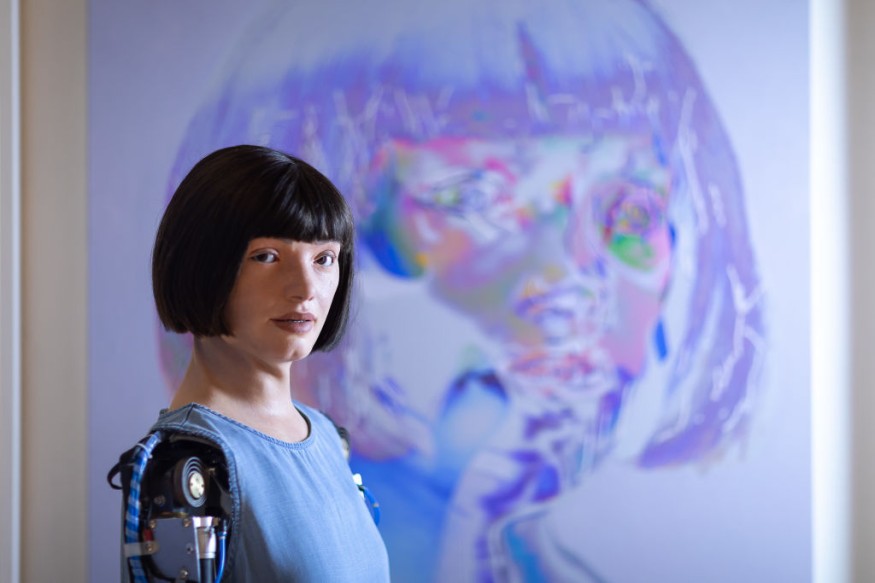
Robots could come in different sizes and forms, but the most endearing and intriguing of them all are those that resemble humans. These humanoid robots are designed for healthcare, public relations, personal assistance and caregiving, research and space exploration, education, entertainment, manufacturing and maintenance, and search and rescue.
The Global Humanoid Robot Market is estimated to be $1.5 billion in 2021 and predicted to reach up to $5.6 billion by 2026, Business Wire reported. Below are the top 10 most advanced humanoid robots in the world that are in existence today.
Ai-Da stands in front of one of 'her' artworks during "Ai-Da: The World's First Robot Artist" press view at Design Museum on May 18, 2021 in London, England.
1. Ai-Da
According to its website, Ai-Da is the world's first ultra-realistic artist robot that uses the camera in her eyes and artificial intelligence to control its arms and draw. Ai-Da was created in February 2019 and had her first solo show at the "Unsecured Futures" exhibit at the University of Oxford, where her art encourages people to think about the rapidly changing world.
Her work represents a significant integration of technology into modern society as art can be viewed differently by different people. Her creative program is designed under a criteria Professor Margaret Boden has set that require her works to be new, surprising, and of cultural value.
2. Sophia
Hanson Robotics' Sophia is perhaps the most recognizable face of a humanoid robot worldwide. The Hong Kong-based company designed Sophia in a way that depicts the future of AI and robotics as her character captures the imagination of people around the world. She has appeared in many TV shows and international conferences to showcase cutting-edge technology for robotics and AI research.
3. Ameca
Ameca is touted as the most advanced humanoid robot in the world, representing the forefront of humanoid robotics. In a video shared on December 2021 by its creator, the British company Engineered Arts, it can be seen that the robot is warming up its shoulder before opening its eyes and expressing a "shock" look.
The robot can even blink and appears to observe its arms, admiring the combination of its mechanical limb, ligaments, sensors, and actuators. Its facial expressions certainly looked realistic, and the team's next step will be to make it walk around.
4. Surena
Researchers at the University of Tehran introduced a rudimentary humanoid robot about a decade ago. After many years, several improvements were made. In 2021, the team introduced Surena IV. The new robot is a major improvement from its predecessors in terms of design, the capability of mimicking a person's voice, grasping a water bottle, and writing its name.
5. Erica
Erica is a Japanese robot created by Hiroshi Ishiguro, the director of the Intelligent Robotics Laboratory at Osaka University. The humanoid robot is an advanced android designed as a research platform to study human-robot interaction. Erica can understand natural language, has a synthesized human-like voice, and can display different facial expressions.
6. Nadine
Nadine is a humanoid robot developed by Kokoro Japan and Nanyang Technological University. The robot looks like an actual human with a body and life-like features. Nadine can make eye contact, shake hands, chat, and even recognize customers from their previous visits. She currently works as a customer service agent at the insurance company AIA Singapore.
7. Pepper
Pepper is the first social humanoid robot in the world to recognize people's faces and emotions, according to its website. As a social robot, she is designed and optimized for human interaction to engage people through conversation and a touch screen. Pepper is now available in over 2,000 businesses and schools as an assistant to welcome, inform, and guide visitors.
RELATED ARTICLE : Should Humans Be Afraid of AI Humanoids? Engineered Arts CEO Says Not to Worry About Weaponizing Droids
Check out more news and information on Robotics in Science Times.
© 2026 ScienceTimes.com All rights reserved. Do not reproduce without permission. The window to the world of Science Times.












